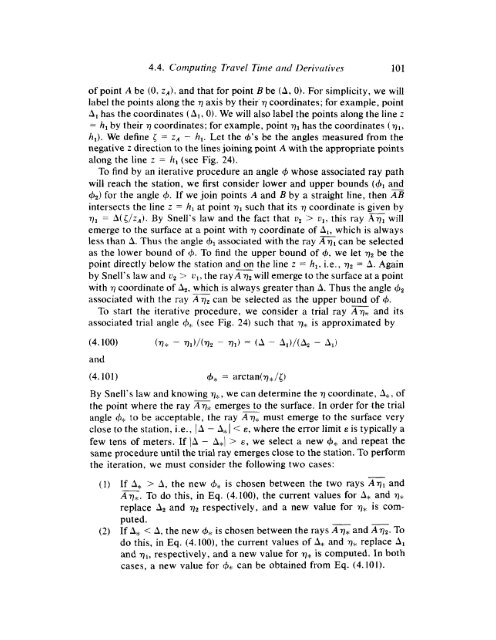principles and applications of microearthquake networks
principles and applications of microearthquake networks
principles and applications of microearthquake networks
You also want an ePaper? Increase the reach of your titles
YUMPU automatically turns print PDFs into web optimized ePapers that Google loves.
4.4. Conipu titig Tru vel Time <strong>and</strong> Derivu tives 101<br />
<strong>of</strong> point A be (0, zJ, <strong>and</strong> that for point B be (A, 0). For simplicity, we will<br />
label the points along the r) axis by their q coordinates; for example, point<br />
Al has the coordinates ( Al, 0). We will also label the points along the line z<br />
= h, by their +I coordinates: for example, point ql has the coordinates ( ql,<br />
hl). We define 5 = zA - h,. Let the d’s be the angles measured from the<br />
negative z direction to the lines joining point A with the appropriate points<br />
along the line z = h, (see Fig. 24).<br />
To find by an iterative procedure an angle 4 whose associated ray path<br />
will reach the station, we first consider lower <strong>and</strong> upper bounds ($1 <strong>and</strong><br />
&) for the angle 4. If we join points A <strong>and</strong> B by a straight line, then<br />
intersects the line z = h, at point ql such that its q coordinate is given by<br />
q1 = h( ul, this ray A X will<br />
emerge to the surface at a point with r) coordinate <strong>of</strong><br />
-<br />
A1, which is always<br />
less than A. Thus the angle associated with the ray Aql can be selected<br />
as the lower bound <strong>of</strong> 4. To find the upper bound <strong>of</strong> 4, we let y2 be the<br />
point directly below the station <strong>and</strong> - on the line z = h,. i.e., qz = A. Again<br />
by Snell’s law <strong>and</strong> v2 > ul, the rayA q2 will emerge to the surface at a point<br />
with coordinate <strong>of</strong> A*, - which is always greater than A. Thus the angle 42<br />
associated with the ray Av2 can be selected as the upper bound<br />
-<br />
<strong>of</strong> 4.<br />
To start the iterative procedure, we consider a trial ray A?* <strong>and</strong> its<br />
associated trial angle & (see Fig. 24) such that q* is approximated by<br />
(4.101) 6, = arctan(q,/ E, we select a new +* <strong>and</strong> repeat the<br />
same procedure until the trial ray emerges close to the station. To perform<br />
the iteration, we must consider the following two cases:<br />
-<br />
(1) If A* > A, the new & is chosen between the two rays Aql <strong>and</strong><br />
AX. To do this, in Eq. (4.100), the current values for A, <strong>and</strong> q*<br />
replace A2 <strong>and</strong> q2 respectively, <strong>and</strong> a new value for q* is com-<br />
(2)<br />
puted. - -<br />
If 3% < A, the new & is chosen between the rays A?* <strong>and</strong> AqZ. To<br />
do this, in Eq. (4.100), the current values <strong>of</strong> A* <strong>and</strong> q, replace A1<br />
<strong>and</strong> ql, respectively, <strong>and</strong> a new value for q* is computed. In both<br />
cases, a new value for c$* can be obtained from Eq. (4.101).






